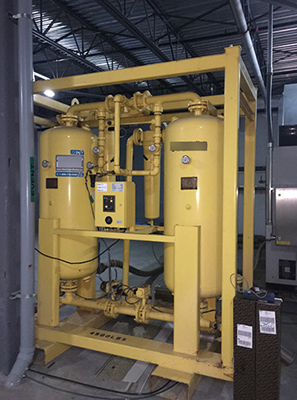 A manufacturer of industrial coatings used a heatless desiccant air dryer to process and condition the compressed air for their complete production process. This 1,500 cfm dryer consumed about 225 cfm of compressed air for its purge flow, which costs about $40,000 per year in equivalent electrical costs, and further had a 10 psi pressure drop across it that consumed $11,000 more in extra compressor energy.
A manufacturer of industrial coatings used a heatless desiccant air dryer to process and condition the compressed air for their complete production process. This 1,500 cfm dryer consumed about 225 cfm of compressed air for its purge flow, which costs about $40,000 per year in equivalent electrical costs, and further had a 10 psi pressure drop across it that consumed $11,000 more in extra compressor energy.
A thorough study of their compressed air consumers by a compressed air auditor found that very dry air was not required for any of the plant processes. The compressed air was distributed only within the heated plant, and none of the processes needed high quality compressed air.
When presented with this, fact the plant production manager protested, claiming he needed at least -20 dew point. The auditor led the manager over to the dew point meter he had installed, the meter showed the desiccant dryer was only producing air at 45° F quality, due to a malfunction. The factory had been operating at this level for a number of weeks with no complaints.
Very often, desiccant dryers are used in systems that have had previous problems with refrigerated dryers not producing adequate dew points. When the desiccant dryer is installed, under the same conditions, somewhat improved dew point is often achieved so moisture problems go away, but the dryer is still producing nowhere near the rated air quality. This slight improvement comes with a significant increase in cost.
After a few months of negotiations, the production manager finally agreed to install a high efficiency cycling refrigerated dryer. An overheating problem causing the inlet temperature to the air dryer was also corrected. Operating at only 50% capacity, this new dryer consumed only $6,000 of energy a year, a reduction of 85%. The reduction of pressure loss due to dryer more efficient dryer filtering lowered the total pressure differential to only 3 psi, saving $7,700 per year in energy costs. Total savings: $42,000 per year!





Leave a Reply